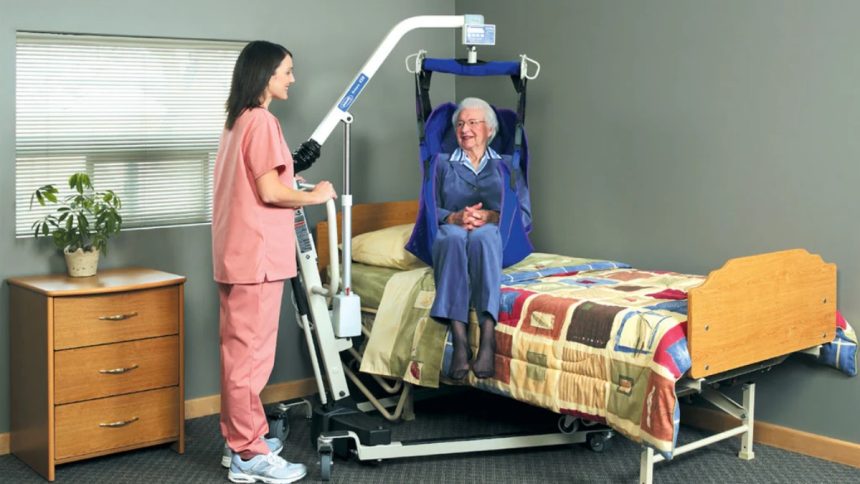Portable patient lifts have transformed patient care by providing a balance of safety and convenience. These tools alleviate stress on caregivers while maintaining patients’ dignity and comfort. Over time, improvements have been made in their functionality and effectiveness, which are discussed in this article, focusing on the modern features of portable patient lifts.
Advanced Safety Features
Safety is a priority in healthcare equipment. Today’s portable lifts include many advanced safety features, like the Joerns Hoyer Advance Portable Patient Lift, which has become the norm. These features help reduce risks during patient transfers. Anti-sway bars and emergency lowering systems are now standard for added stability, and safety concerns are addressed effectively through them. Sensor technology has become more refined to identify obstacles or issues promptly, notifying caregivers when needed. These improvements offer reassurance to users and medical staff and can even be life-saving in certain contexts.
User-Friendly Interface
User-friendly design plays a huge role in how patient lifts perform their tasks effectively. In today’s market, models come with interfaces that are easy to use and simplify the process of operation. Digital screens provide intuitive controls and clear guidance, making it easy to use even for those who are unfamiliar with the equipment. Some of these lifts now come equipped with remote controls, enabling caregivers to manage the lift remotely. This advancement improves adaptability and convenience, adding to a smooth user interaction.
Customizable Options
A key aspect of patient lifts is their adaptability to meet needs and preferences effectively through customizable features, such as adjustable arm supports and variable lift heights. With interchangeable slings, it becomes easy to provide personalized care and ensure maximum comfort and efficiency for individuals.
Portable Design
Modern lifts are known for their portability due to their lightweight designs, which prioritize movement and transportability with the help of advanced materials that make them sturdy yet lightweight. These lifts may feature parts that add to their convenience and ease of portability, which is particularly beneficial in healthcare environments, where space and mobility are key factors. Despite their size and lightweight construction for transportability, these lifts still offer strength and durability in healthcare settings without compromising reliability or usability.
Energy Storage Optimization
Modern mobile elevators have advanced battery technology to enable usage without recharging sessions. Using lasting batteries helps decrease downtime and improves effectiveness in busy healthcare settings. Numerous models now offer charging functions to reduce interruptions during care. Moreover, energy-efficient designs support sustainability, aligning with increasing awareness. These enhancements guarantee that elevators are always available for use when required.
Cutting-Edge Mobility
Inpatient lifts have also experienced advancements that widen their range of applications and mobility options. Swiveling wheels and omnidirectional casters enable maneuvering on different surfaces. These upgrades guarantee seamless and continuous mobility, which lowers the chances of mishaps or inconveniences. Moreover, certain versions can climb stairs, enhancing their utility significantly. These new features enhance access and self-sufficiency for users, thereby improving their overall quality of life.
Enhanced Load Bearing Capability
Ensuring patient lifts can handle weights is essential, and designs have improved to meet this demand well. Current models can support loads as they are built with reinforced structures and durable materials. This enhancement allows a broader range of patients to use the lifts comfortably in healthcare environments, promoting inclusivity and accessibility for all.
Embracing Smart Technology
The incorporation of technology marks a big step ahead for portable patient lifts! Being able to connect with apps allows for monitoring and control from afar, which gives information on how they are used and when they need maintenance. This tech gives caregivers important data that helps in providing proactive care and managing equipment effectively. Additionally, these smart functions can improve communication among healthcare teams, enhance patient safety, and make sure services are delivered in a coordinated and efficient manner.
In Summary
The development of patient lifts demonstrates a dedication to enhancing patient care through technology advancements and improvements over time. These devices have become tools in healthcare due to their safety features, user-friendly interfaces, and integration of smart technology. As technology progresses, we can anticipate advancements that will enhance the well-being of patients and caregivers. By embracing these innovations, we uphold the importance of patient care progressing to ensure dignity, safety, and comfort for everyone involved.
Lynn Martelli is an editor at Readability. She received her MFA in Creative Writing from Antioch University and has worked as an editor for over 10 years. Lynn has edited a wide variety of books, including fiction, non-fiction, memoirs, and more. In her free time, Lynn enjoys reading, writing, and spending time with her family and friends.















